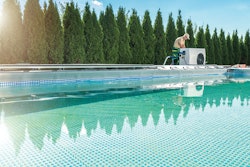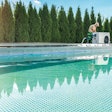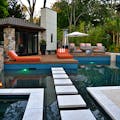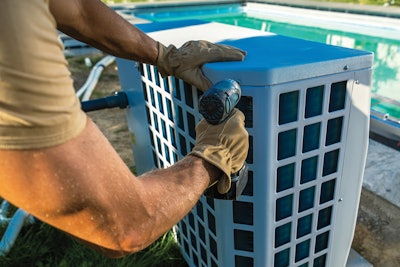
There are three pieces of pool and spa regulation drifting like tree trunks down a flooded river toward your village, and when they arrive, you will notice the effect on local commerce. One big trunk of regulation is national, and the other two are California-only, but even if you don't reside in the Golden State, regulation logs released there sometimes show up downstream in other states within a few years.
NATIONWIDE - PUMP MOTOR BAN
This change affects everyone. Back on July 19, 2021, the US Department of Energy implemented the most sweeping pool pump regulation in the history of the industry. At that time, the new DOE rules ended production of most single-speed pool pumps in the inground residential market.
It was a manufacturer-driven change. That is, on that date,
manufacturers ceased production of non-compliant single-speed and two- speed pumps, and those pumps slowly disappeared from dealer shelves and service department inventories across the continent.
They did not disappear from pools, however. Hundreds of thousands of previously installed, non-compliant single-speed pumps remained right where they were, spinning their lives away.
As these pumps wore down and stopped, the homeowner was faced with a choice: Buy a new, relatively expensive variable-speed pump that would have a high initial price tag but would save energy and money in the long run, OR, they could simply replace their existing pump motor for a relatively small price upfront, and get the system up and running again.
That conversation went something like this:
"For pumps, only VSPs are legal now. Shall I order you a VSP?"
"How much are they?"
"Installed? $2000... give or take..."
"Do I have any other options?"
"Well... technically yes, but..."
"How much is the 'technically-yes-but' option?"
"$300... give or take.."
"Sweet. I'll take that."
Some people chose to go that route and, as such, motors had not been banned (except in California).
Well, as of September, such motors will begin their journey to oblivion in accordance with DOE regulation. Supplies will dwindle and disappear, as will the option to continue using non- compliant, low-efficiency pumps.
This new DOE motor regulation is a tiered standard, with the first tier going into effect in September 2025, and the second tier in 2027. (And pool pros in California should note that the new national DOE standard, which will supersede the California standard, is slightly different than the one they've been using for the last four years. More on that to come in subsequent articles.)
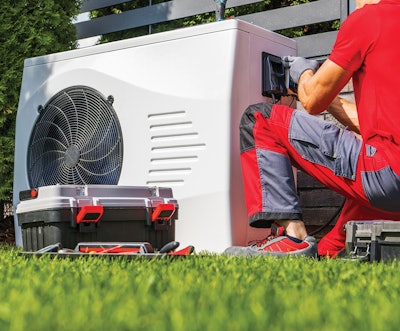 The future of California pool and spa heat belongs to solar thermal and heat pumps like this one, with a diminishing role for gas.
The future of California pool and spa heat belongs to solar thermal and heat pumps like this one, with a diminishing role for gas.
COMING SOON IN CALIFORNIA
When it comes to pool and spa industry regulation, California is a bellwether state. Actually, it is the bellwether state. That is, statutes and standards that emerge in Sacramento are evaluated by the rest of the US and often approved for a wider audience. California is, after all, the largest pool and spa market in the world, and thus drives trends across North America and beyond.
For that reason alone, pool and spa professionals from coast to coast should take notice of two initiatives coming online within the next 12 months in California. (And obviously, for the multitude of California aquatic pros reading this, here is what has already arrived at the doorstep.)
FLEXIBLE DEMAND CONTROLS
Pool controls manufactured on or after September 29, 2025, will have to meet new requirements spelled out in "Title 20 Flexible Demand Appliance Standards" or FDAS. Manufacturers, distributors, retailers, and installers in the state will be required to only sell products that comply with the new regulations.
It is the first step in the process that seeks the installation of controls that come with a functionality that, with consumer consent, have the capability to connect to the grid, utilities, or other third-parties. These controls will allow remote operation — such as shutdown/startup of pool pumps and electric heaters.
Once the infrastructure is in place, consumers who opt-in will have pool and spa equipment that can send and receive signals from the grid, utilities or third-party entities in order to better manage energy consumption and flow through the grid, particularly during times of high demand.
To be clear, actual remote control of the enormous pool population of California will not begin in September. This step just begins to put the means in place. Once complete, when the state wants to start flexible demand programs and third party remote control, the pieces will be in place to do it — products that can connect.
As of September, 2025, equipment manufacturers will have to start selling compliant equipment and systems that are certified by the state. Distributors, retailers, and installers will join the process of verifying that new equipment sold meets the standard.
This is, of course, a new concept in pool regulation, and there's much work to be done to educate and implement a plan on this scale.
At the moment, for builders, service pros and retailers, there's not much to do to get ready for FDAS. It's the manufacturers that have the biggest action item and deadline. They must design, manufacture, mark and certify compliant controls, and be ready to start selling them by September. Which isn't as easy as it sounds, but that's another story.
OK, there's one more big change coming — for California pool heating.
NEW POOL AND SPA HEATING REQUIREMENTS
There will be new requirements for swimming pool and spa heating in the state of California effective January 1st, 2026.
Simply put, gas will no longer be allowed as the primary heating source for pools and spas adding a heater for the first time (a heater on a new pool, or a heater being added to an existing pool for the first time). That's the bottom line. When introducing heat to a new or existing pool, starting in 2026 in California, these shall be the three available options for the primary source of heat:
1. Solar thermal
2. Heat pumps
3. Heat recovery systems
The word "primary" above means you can have a gas backup in certain cases as defined in the legislation.
Of course this new regulation does not touch existing gas heaters, only new installations, and will contain important exceptions and distinctions. Combinations of systems are allowed. Like all such regulations, the text of the document is arcane and will require further clarification (and possibly litigation) over the coming year(s).
HISTORIC MAGNITUDE
These are the basics of regulatory changes that will affect nearly all parts of the pool system — pumps, heaters and controls (there's nothing about filters so far). Depending on one's location and industry sector and point of view, these three changes taken together could be considered of the same magnitude as DOE's VSP rule in 2021 or VGB in 2007.
For the new California rules, the details of exactly what equipment is compliant, in what btu ranges, etc., and what exceptions are allowed, will be important. This article is meant as a heads-up, qualitative report. AQUA will follow up with more specifics on each standard.
This article first appeared in the January 2025 issue of AQUA Magazine — the top resource for retailers, builders and service pros in the pool and spa industry. Subscriptions to the print magazine are free to all industry professionals. Click here to subscribe.

























